Monday, March 22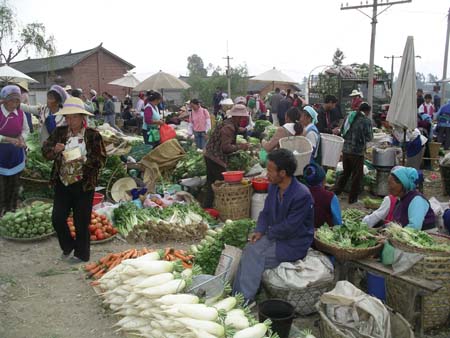
Paula: Today we planned a leisurely day exploring local
villages and marke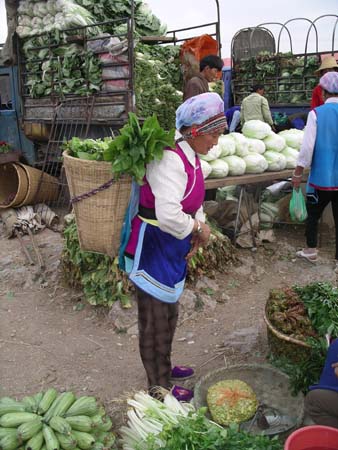 ts.
We have realized that markets provide a great insight into people and their
lifestyles. We can see what people eat and buy for their homes. We often get
a feel for services like barbershops, repair shops and even healthcare. We
can observe what people wear and how they get from place to place. We see
how people interact with one another and with us. Even the way that people
carry things through the markets is always different in each place we go.
We find that visits to markets never disappoint us.
ts.
We have realized that markets provide a great insight into people and their
lifestyles. We can see what people eat and buy for their homes. We often get
a feel for services like barbershops, repair shops and even healthcare. We
can observe what people wear and how they get from place to place. We see
how people interact with one another and with us. Even the way that people
carry things through the markets is always different in each place we go.
We find that visits to markets never disappoint us.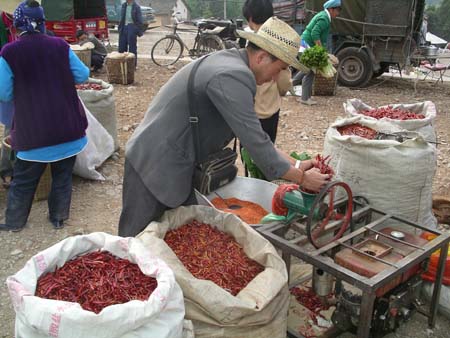
Our first stop of the day was Sha Ping, a large market which serves five
local villages. The market was crowded with local people eating, purchasing
food, livestock and household supplies. We saw many kinds of tobacco, 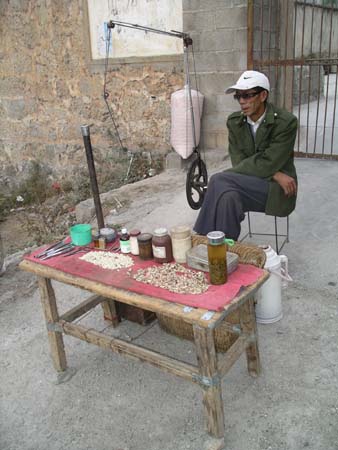 tea,
spices, and of course fruits and vegetables. Large bags of chilies were being
ground for chili powder. Huge incense sticks were being sold for the temples.
We had fun observing people negotiating over the purchase of piglets and then
watched in amusement as the pigs were loaded with their new owners into a
tuk-tuk.
tea,
spices, and of course fruits and vegetables. Large bags of chilies were being
ground for chili powder. Huge incense sticks were being sold for the temples.
We had fun observing people negotiating over the purchase of piglets and then
watched in amusement as the pigs were loaded with their new owners into a
tuk-tuk. 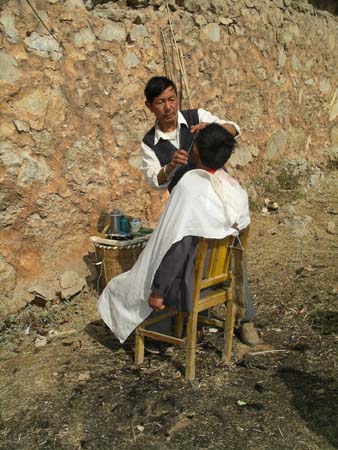
Again we saw a dentist (pictured here on the left) in the middle of the market advertising his expertise by displaying all the teeth he has pulled in front of his dentist chair. A scary-looking contraption with a large wheel sat beside him - we were shocked to learn that this is what he uses for the extraction process!
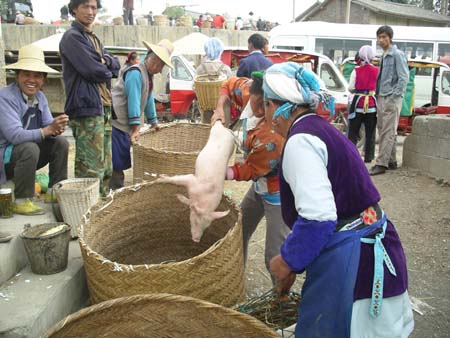 The
women as always were colorful as they carried large bundles of goods and purchases
in wicker backpacks. They actually place the strap from the backpack across
their forehead for extra heavy loads.
The
women as always were colorful as they carried large bundles of goods and purchases
in wicker backpacks. They actually place the strap from the backpack across
their forehead for extra heavy loads. 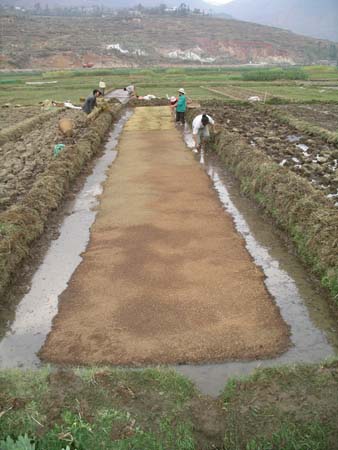
Many people were working on their farms today and after leaving Sha Ping
we decided to walk into the fields to have a closer look at what they were
doing. Many were actually preparing narrow plots in preparation for growing
rice seedlings. 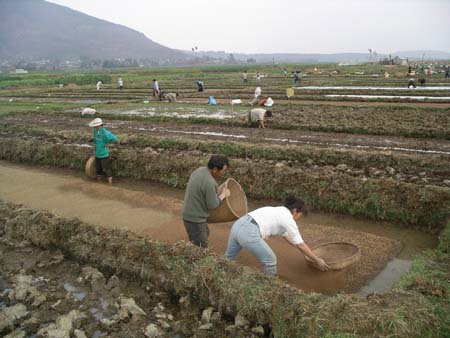 It
is quite a process to prepare each plot and the work is all done by hand.
After tilling the soil with large hoes, the soil is worked until it is loose
and moist. It is then leveled and rice seeds are spread on top. Next, a fine
layer of fertilizer (usually dust, ash and manure) is spread on top. Finally,
a layer of straw or plastic is used to cover the seeds to keep them moist
and warm until they seeds germinate. After the seedlings are about a foot
high, they are ready to be transplanted into the rice paddies. We were fortunate
to see the seedlings being transplanted while we were in Vietnam, so now we
just need to see the harves
It
is quite a process to prepare each plot and the work is all done by hand.
After tilling the soil with large hoes, the soil is worked until it is loose
and moist. It is then leveled and rice seeds are spread on top. Next, a fine
layer of fertilizer (usually dust, ash and manure) is spread on top. Finally,
a layer of straw or plastic is used to cover the seeds to keep them moist
and warm until they seeds germinate. After the seedlings are about a foot
high, they are ready to be transplanted into the rice paddies. We were fortunate
to see the seedlings being transplanted while we were in Vietnam, so now we
just need to see the harves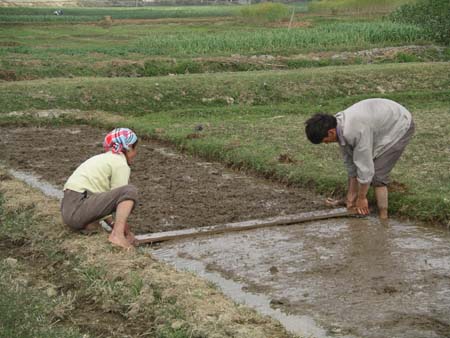 t
- I guess that means another trip to Asia at sometime in the future.
t
- I guess that means another trip to Asia at sometime in the future.
Before leaving the fields, we spent time talking with two older women tilling
the soil. They were both in their sixties and told us they had been 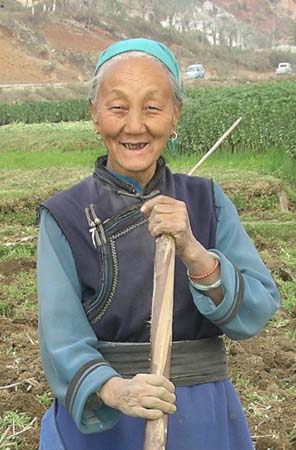 farming
for over fifty years. It was amazing to see them slam their hoes into the
ground, easily loosening the packed soil. We couldn't believe how strong these
women were! David and Katie both took turns helping them for a short time
and were surprised at how difficult it was to work the soil. The farmers all
enjoyed seeing the kids help and laughed at how they struggled. They wanted
us to stay and have a picnic lunch with them but we had to politely refuse.
Before leaving, we snapped some wonderful photos of them and their granddaughter
to help us remember this
farming
for over fifty years. It was amazing to see them slam their hoes into the
ground, easily loosening the packed soil. We couldn't believe how strong these
women were! David and Katie both took turns helping them for a short time
and were surprised at how difficult it was to work the soil. The farmers all
enjoyed seeing the kids help and laughed at how they struggled. They wanted
us to stay and have a picnic lunch with them but we had to politely refuse.
Before leaving, we snapped some wonderful photos of them and their granddaughter
to help us remember this 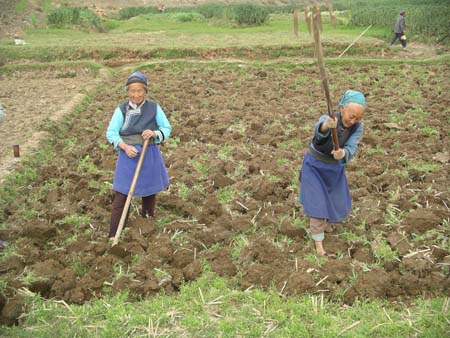 experience.
experience.
We also stopped in the village of Xizhou before lunch and enjoyed walking
down the streets and examining the gates of the many homes. Lee told us that
the roof design on traditional homes is meant to resemble the heads of two
dragons. We had fun purchasing one of the local 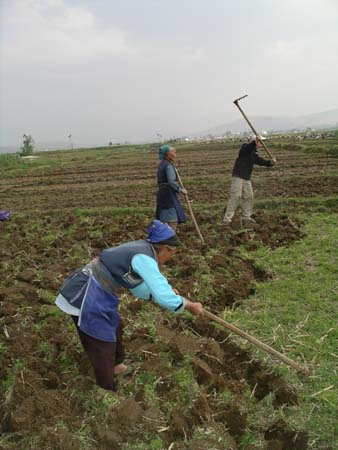 headdresses
for Katie.
headdresses
for Katie.
Lunch was in a small hotel just outside the old city. Lee told us that the
local restaurants serve food that is really much too spicy for even the most
tolerant Westerner. After seeing all the chili powder in the market, we were
inclined to believe him. Fortunately in Dali, the 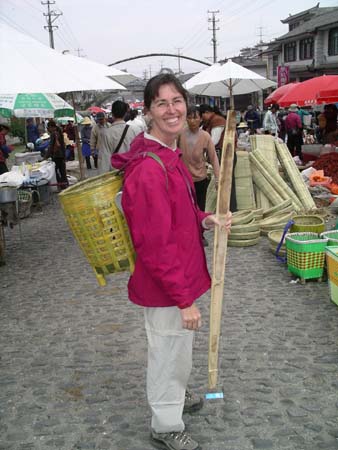 tourist
menu has been much tastier and we have had several nice meals.
tourist
menu has been much tastier and we have had several nice meals.
Before leaving the old city, we decided to check out the local market here
as well. We had been debating about purchasing one of the wicker backpacks
used by all the local people here and finally decided to get one for ourselves.
After negotiating a great price we were inspired and David and Katie each
took turns bargaining for additional wicker baskets and a bamboo pole to attach
them to just like the farmers use in the fields. All these purchases cost
us less than $5 in total, and it will be exciting to 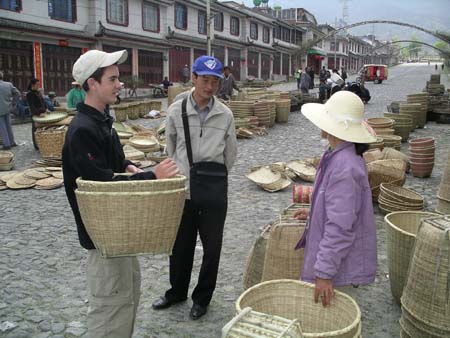 bring
home these very "real" mementos.
bring
home these very "real" mementos.
We also learned a bit more about how the pricing and negotiating process
works here in China. As an experiment, we decided to buy two items from a
street vendor - a small statue and a very nice wooden hanging containing an
engraved poem. Steve handled this negotiation. The woman first quoted a price
of 250 Yuan 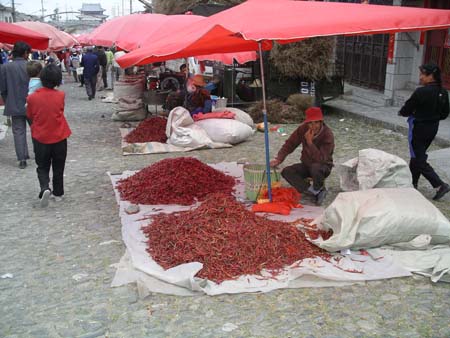 (roughly
$30) for the two items. Steve responded by shaking his head and came back
at 80 Yuan. The woman laughed and said absolutely not, but came down to 230
Yuan. Steve said no and repeated his offer of 80 Yuan, then started walking
away. This process repeated itself several times, and Steve never budged from
the 80 Yuan offer. Finally, after the woman had tried prices of 200, 150,
100 and finally 90,
(roughly
$30) for the two items. Steve responded by shaking his head and came back
at 80 Yuan. The woman laughed and said absolutely not, but came down to 230
Yuan. Steve said no and repeated his offer of 80 Yuan, then started walking
away. This process repeated itself several times, and Steve never budged from
the 80 Yuan offer. Finally, after the woman had tried prices of 200, 150,
100 and finally 90, 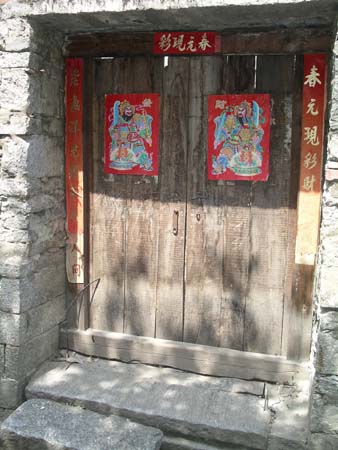 she
agreed to the 80 Yuan! What this proved to us is that people quote outlandishly
high prices (like 250 Yuan), hoping that their buyers will come back with
offers (say 180 Yuan) that are still much higher than the real price they'll
sell for. After this was all over, Lee
she
agreed to the 80 Yuan! What this proved to us is that people quote outlandishly
high prices (like 250 Yuan), hoping that their buyers will come back with
offers (say 180 Yuan) that are still much higher than the real price they'll
sell for. After this was all over, Lee 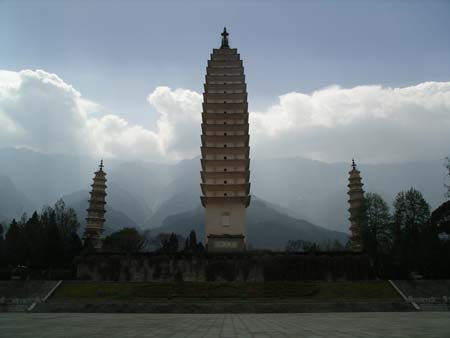 told
us that the items we purchased probably cost her 50 Yuan, so she still made
a nice profit with the 80 Yuan sale!
told
us that the items we purchased probably cost her 50 Yuan, so she still made
a nice profit with the 80 Yuan sale!
Just outside of Dali, standing on a hillside with magnificent mountains as
a backdrop, stands San Ta Si or Three Pagodas. The tallest pagoda was built
in 839 A.D. and is one of the oldest standing structures in southwest 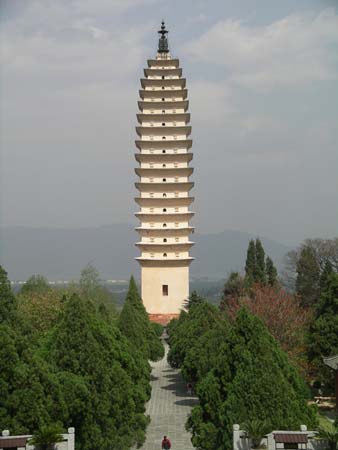 China.
The pagodas were recognized by the Central Party as a part of China's national
heritage in 1961 which saved them from destruction during the Cultural Revolution
of the 1960s and 1970s. Originally the site of a huge monastery with
China.
The pagodas were recognized by the Central Party as a part of China's national
heritage in 1961 which saved them from destruction during the Cultural Revolution
of the 1960s and 1970s. Originally the site of a huge monastery with 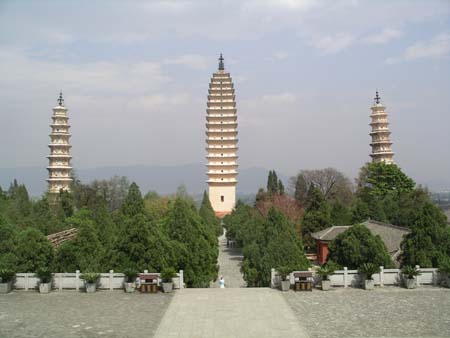 over
1,000 Buddhist monks, today this site is generally only visited by tourists.
over
1,000 Buddhist monks, today this site is generally only visited by tourists.
While the three pagodas have not required restoration, all the other buildings
on the site including a large temple have been constructed by the government
during the past five years. We thought this was interesting given that our
guide Lee told us that the temples on the site were demolished by the Central
Party and the monks expelled during the Cultural Revolution. Lee says the
government doesn't want to encourage Buddhism among the local 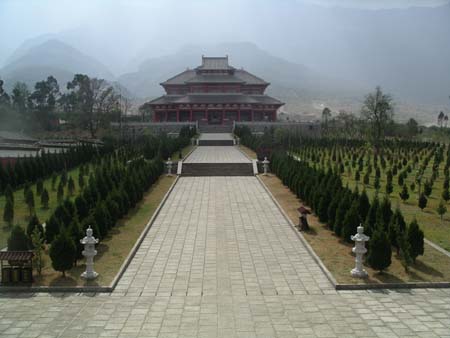 people
but they want the tourist money and therefore reconstructed the temples even
though there are no monks on site. A small museum contains many of the original
relics including many old statutes of Guanyin, the Buddha form commonly worshipped
here.
people
but they want the tourist money and therefore reconstructed the temples even
though there are no monks on site. A small museum contains many of the original
relics including many old statutes of Guanyin, the Buddha form commonly worshipped
here. 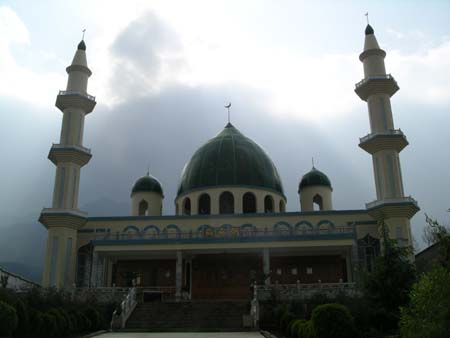
Muslims are also an ethnic group found in this part of China. We visited one of six Muslim villages in Dali and discovered a beautiful new mosque. It was interesting to see Arabic writing alongside the Chinese characters. It also dawned on us that to face Mecca while in China requires that you face west instead of east as we have done in all the other mosques we have seen on the trip so far. The village has its own primary school and we could hear the children learning Arabic. The women wore head covers similar to those in Turkey and Morocco.
We ended the day, by walking down through the old city and settling into a small pizzeria for dinner. It was nice to have a Western meal for a change. Tomorrow we will be visiting a school and hospital here as well as taking an excursion to the town of Weishan, famous as a center of Taoism.
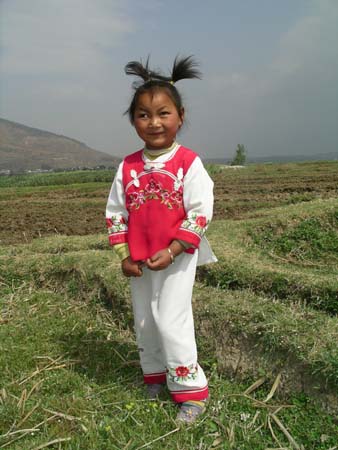
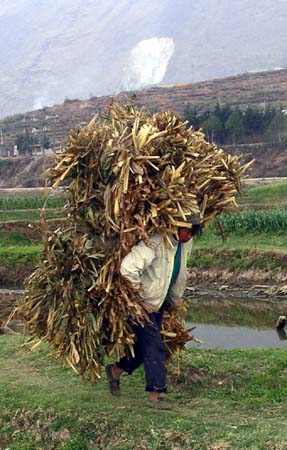
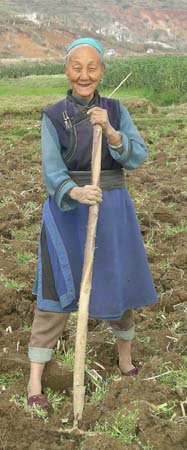
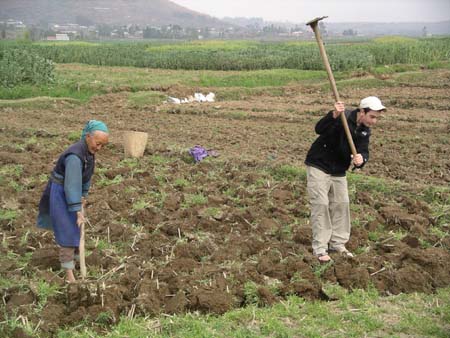
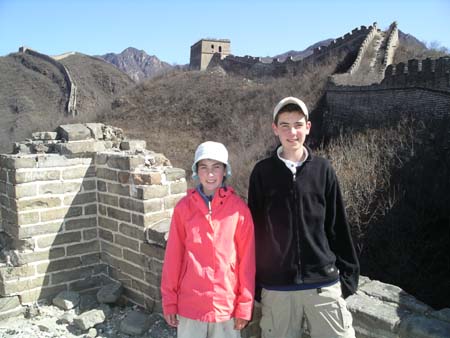
Katie's Kwick Kwacks: My Impressions of The Great Wall of China. While we were in Beijing, we visited the world famous Great Wall of China. Our experience here was surely one we will never forget. The next paragraphs describe our exciting day on this Great Wall and my impressions of it.
As we walked across the narrow stone plank I knew this wasn't going to be any usual site seeing excursion - it was going to be an adventure. Before today, I wasn't really sure what to expect from this wall. I heard stories of it being extremely touristy and reconstructed from its original state. One thing was for sure, we were not in the normal spot. As I took my first step onto the wall, I felt a wave of apprehension. There was no one in sight, and the path ahead had no railings or modern equipment. We were standing on the real Great Wall of China. As we made our way along the rigid path, I felt as if I were an archaeologist on a National Geographic show. It was just as I had imagined it. There were scraps of stone everywhere, and we were heading uphill in a freezing wind chill. Along the sides of the wall were beautiful ramparts and shooting holes used during invasions by the ancient Chinese army. These fortifications line the entire wall with diamonds as it descends off into the distance.
The wall alone, however, does not make up the complete beauty of this scene. The most magical thing about the structure is how it snakes throughout the mountains and valleys, making it look impossible to build. The wall twists and curves in all directions - it looks like it's made of extremely flexible rubber! The only things dividing this endless wall's twisted structure are the watch towers.
